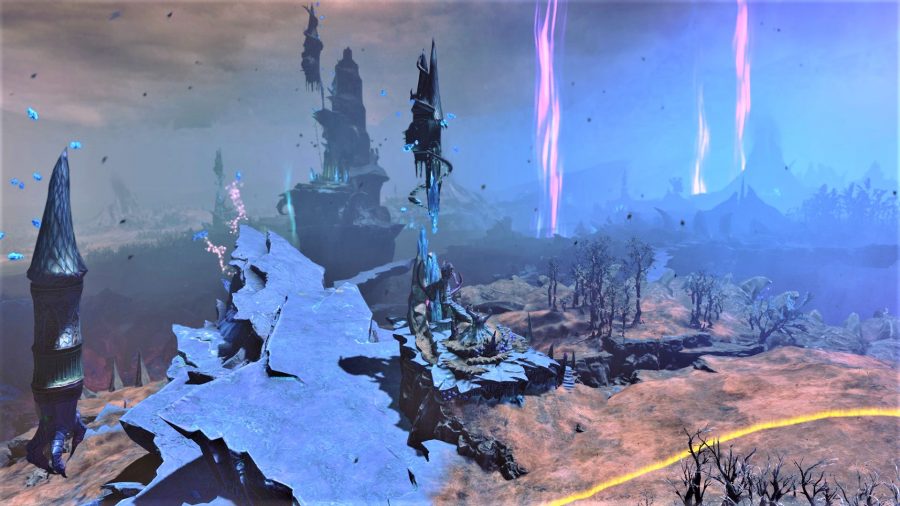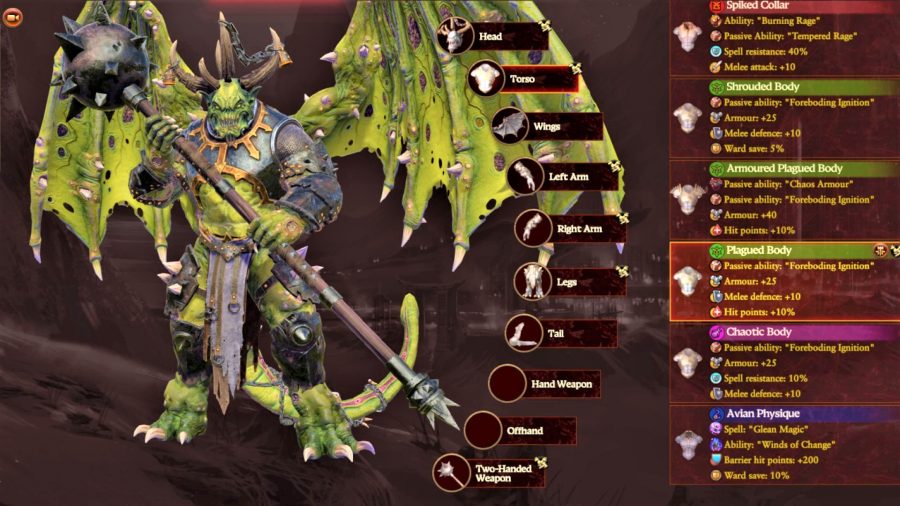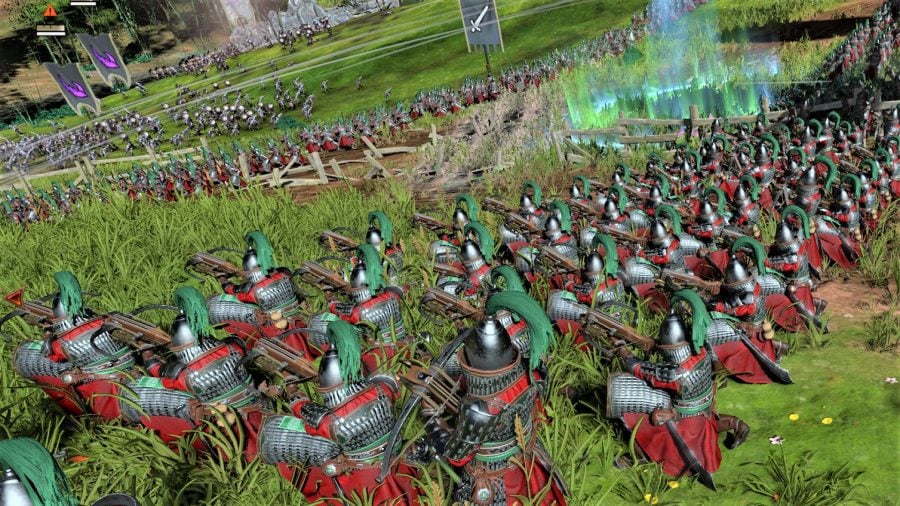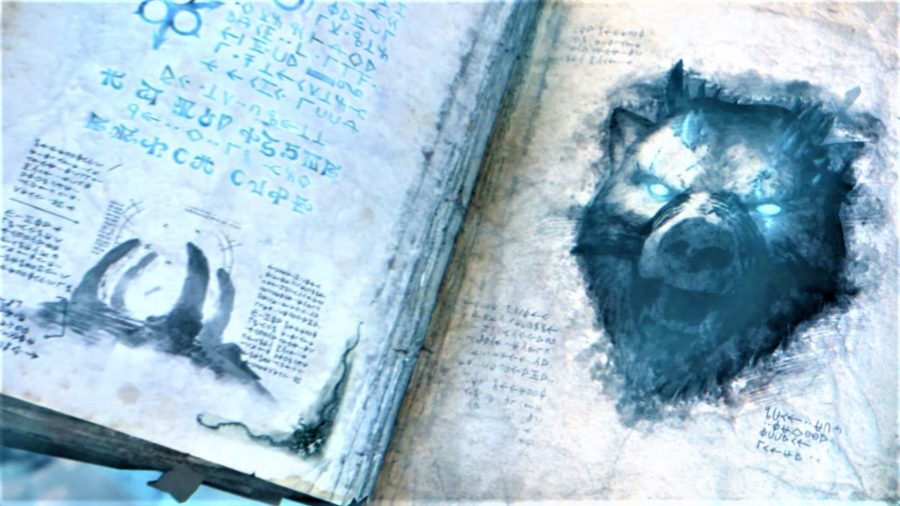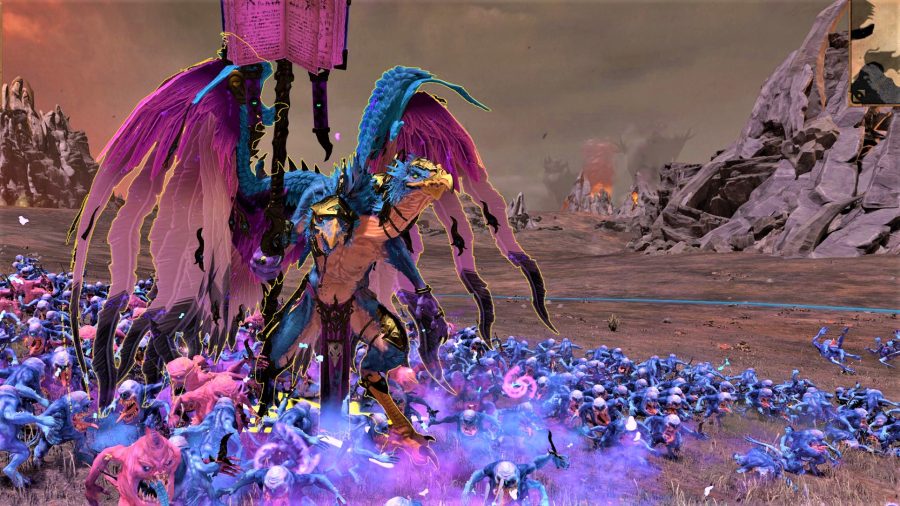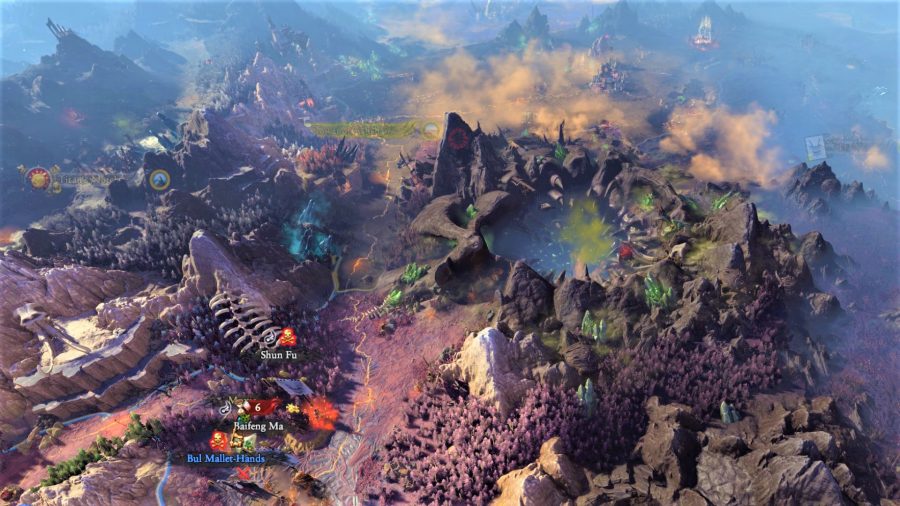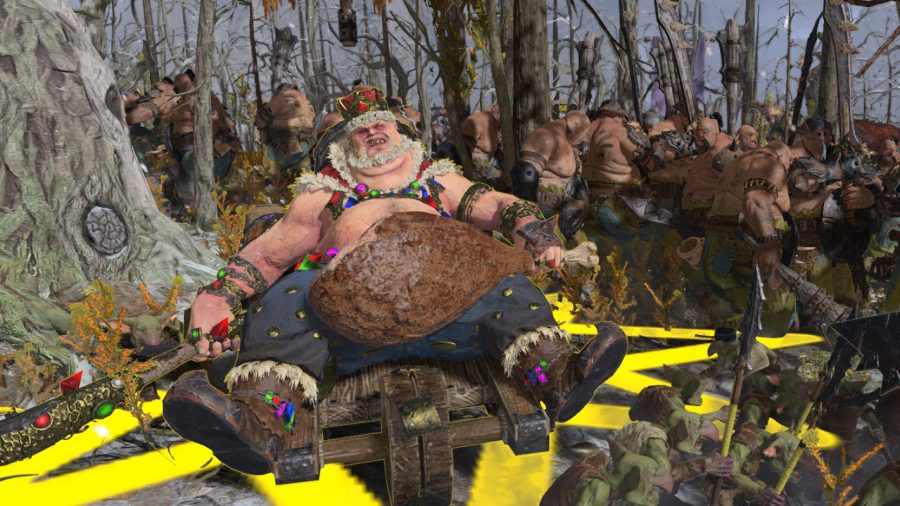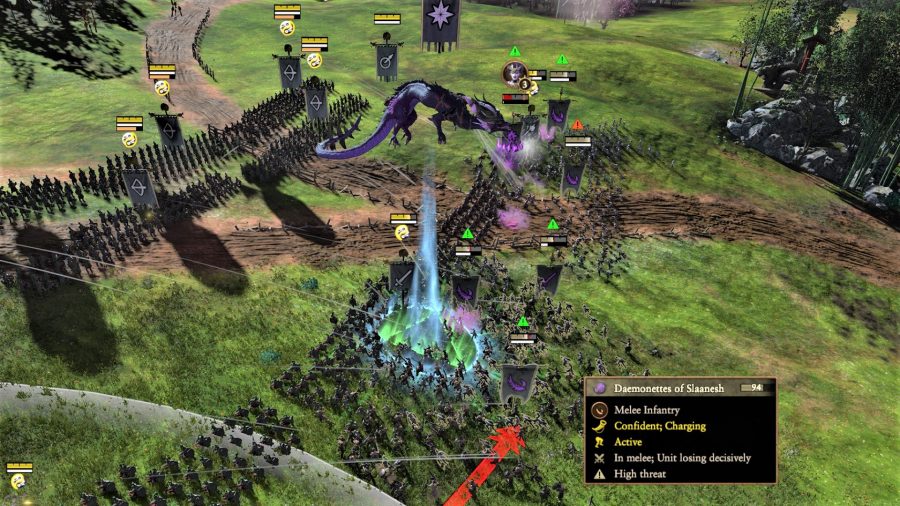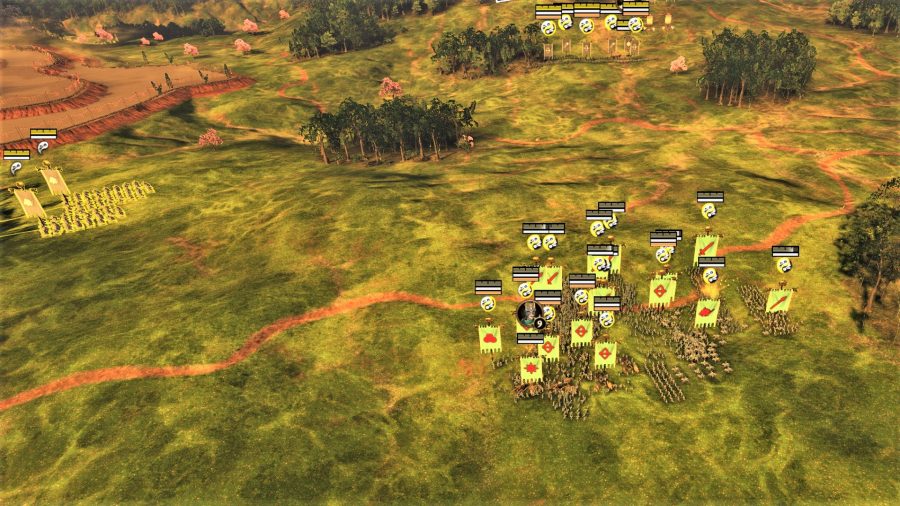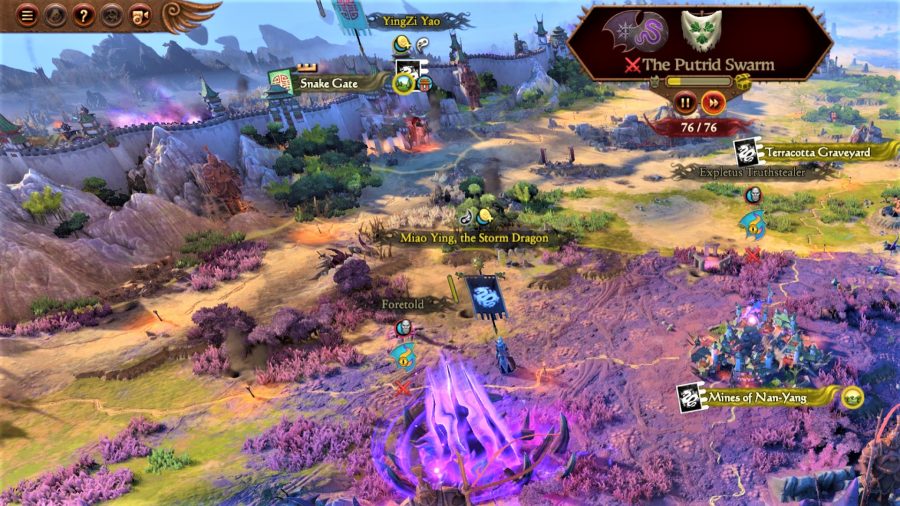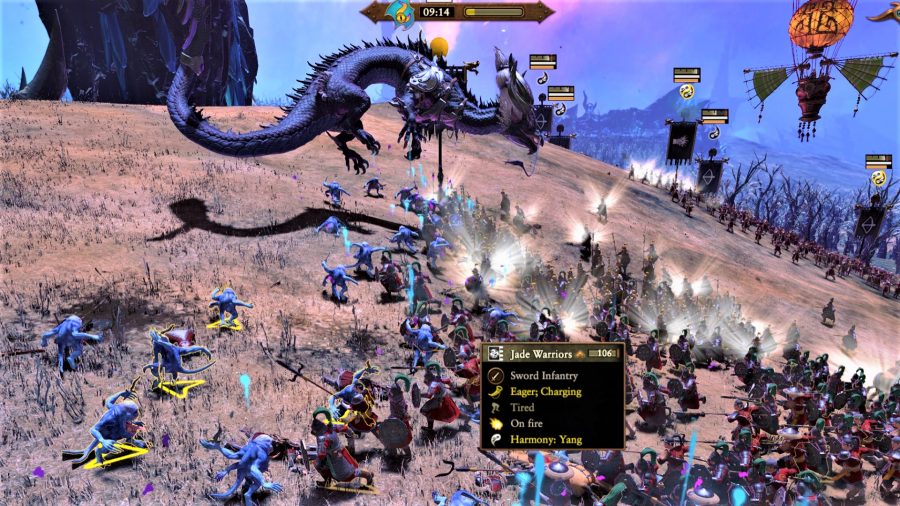Dark gods be praised! With a fanfare of daemonic snarls, massed wingbeats, and the dimension-shaking roars of an imprisoned bear-deity, Total War: Warhammer 3 has finally arrived. Half a decade after developer Creative Assembly (CA) served us up its last, enormous helping of grand strategy and real-time battles in Warhammer’s Old World fantasy setting, the landmark trilogy’s final chapter is upon us.
Players of the series were promised an evolution of the ‘Total Warhammer’ experience that’s bigger and better in nearly every way: more faction choices; more meaningful faction campaign mechanics; a more satisfying storyline; better siege battles; a completely overhauled set of multiplayer modes; and – perhaps most challenging – all four Chaos gods and their daemonic legions fully realised as playable factions.
Fans of Warhammer 40k, Age of Sigmar, and The Old World are used to being let down by Warhammer videogames. Few among us truly reckoned that even CA (the safest pair of hands yet entrusted with digitising Games Workshop’s fictional worlds) would deliver anything more ambitious than ‘more of the same’. Frankly, we’d probably have eaten warmed up seconds of 2017’s Total War: Warhammer 2 and been grateful for it. All the more impressive, then, that Total War: Warhammer 3 is a bona fide slam dunk of a game that delivers on all of those promises (plus a bit more) to make me very excited about the next five years of Warhammer PC gaming.
The breadth and depth of Total Warhammer 3’s single player campaigns, above all, display a great leap forward. In TW2, CA proudly offered a range of differentiated campaigns, with its four launch factions (Skaven, Lizardmen, Dark Elves, and High Elves) each boasting unique and meaningful faction mechanics that affected their strategies and made playing them feel unique.
TW3 turns this up to 11, keeps turning, breaks the knob off the amplifier, pours gasoline all over it, and sets it on fire. Follow me, if you please, into the Realms of Chaos…
Eight paths lie before you
If you pick up the game in time to scoop the pre-order bonus Ogre Kingdoms faction, TW3 includes eight playable factions – double that of its predecessor. Every one I’ve sampled (so all except Kislev, Khorne, and Slaanesh) has been injected with more bonkers, oil-painted Old World fantasy flavour and gameplay-altering oddities than anything TW2 offered at launch.
Front and centre are the five factions representing different aspects of Chaos – the colourful, crazed wildcard of the Warhammer worlds, and the point at which its worldbuilding takes a sharp left turn away from Tolkienesque tribes and tropes, into playful, psychedelic fantasy horror.
Each chaos god plays differently – it’s very, very good stuff
Play the daemons of the blood god Khorne, and you’re an elemental force of destruction, gaining momentum and power only through constant slaughter, city-razing, and skull-collecting. Align with grandfather Nurgle, and you’ll be whipping up delightful diseases to spread across the map – while dealing with bizarre entropic side effects, like buildings that upgrade themselves, only to wither and die again. Play as the change-god Tzeentch, and you’ll collect hundreds of spellbooks in order to enact powerful magical plots – forcing rivals to declare war on each other, or simply hand you their cities without a fight. Jump into bed with the Dark Prince Slaanesh and impose constant seductive force on all around you – raising hosts of weak-minded mortal devotees, stealing control of enemy units in battle, or ensnaring entire factions into becoming vassals.
Or – secret option number five – you can be your own, self-named, unaligned Chaos Daemon Prince, with a chip on their shoulder and a penchant for collecting an extended chaotic wardrobe.
Win battles in different gods’ names, and they’ll grant you new mutated body parts and wargear that you can mix and match, Barbie doll style, to create the vicious winged hellspawn of your dreams – then see it strut its stuff on the battlefield. There are even ARPG/looter-shooter style ‘sets’ of gear to unlock, that give extra bonuses when you equip ‘em all.
Far future: These are the best Warhammer 40k videogames
In strictly scientific terms, it’s nuts. Not since Dawn of War 2, arguably, has a Warhammer videogame made this good a fist of recreating the rich, model-customising, roleplay-like experience offered by ‘kitbashing’ custom character minis for tabletop Warhammer.
This is very, very good stuff.
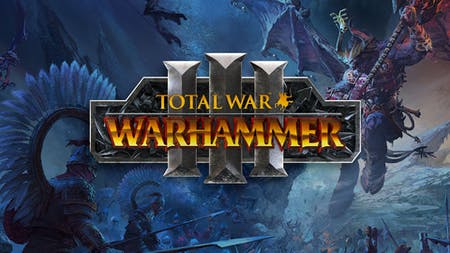 Total War: Warhammer III Total War: Warhammer III $59.99 $47.39 Pre-order Network N earns affiliate commission from qualifying sales.
Total War: Warhammer III Total War: Warhammer III $59.99 $47.39 Pre-order Network N earns affiliate commission from qualifying sales.
Even the non-Chaos factions are meatier and more interesting than previous fare. My first choice, Grand Cathay, may have a slightly more pedestrian unit roster than the Chaos gods’ Crayola parade of slavering daemons and mutants – but it’s blessed with a rich bounty of faction-based bells and whistles to play with, all of which simultaneously draw relevance from, and add authenticity to, the faction’s visually stunning homeland and unsubtle ‘mystical medieval China’ theme.
Cathay has to balance protecting its Grand Bastion with pursuing the story
In my estimation, the core ‘Harmony’ mechanic of balancing buildings, techs, and army building between ‘Yin’ and ‘Yang’ feels a little over-egged at times. But striking a strategic balance between your ancestral duty to protect the ‘Grand Bastion’ (read: Great Wall) against Chaos incursions, and pursuing your main story arc (all the while managing a quite crunchy economic system of trade caravans) makes for a properly distinctive experience. I’ve not yet played as Kislev, but its mechanics of perpetual political wrangling with nobles and religious authorities presage an equally heavy-duty, self-contained game to be had.
And that’s all before we’ve dealt with the main story itself.
Bear necessities
TW3 holds on to its predecessor’s overarching, in-game ‘race to the finish’ narrative structure – but improves on TW2’s Eye of the Vortex storyline in every way I can think of. Instead of an arbitrary, impersonal, mystical McGuffin in the centre of the map that every faction wants for ill-explained reasons, this time we get a straightforward, energetic, character-driven plot that’s clear-cut from the outset.
The next chapter: Our guide to all the Age of Sigmar armies
Be’Lakor, a powerful Chaos Daemon Prince, has captured Ursun, the celestial bear-god of Kislev, and is holding him, close to death, in what’s basically the deepest circle of hell. Your job is to get in there, defeat Be’Lakor, and either steal Ursun’s power for yourself, release him, or some other mission, depending on your faction. That’s it. Simple.
Each faction’s motivation is fully explained in pre-game cinematics and intro text. Tzeentch’s Legendary Lord Kairos Fateweaver, for example, wants the bear’s divine eyes to help with his scrying; Cathay wants Ursun’s help to rescue a lost member of its draconic royal family; the Ogres… well, the Ogres just want to eat Ursun. Because they mainly just like to eat stuff. The point is: whichever lot you choose, your goal is clear as mud from the off – and that’s a deceptively big improvement in terms of immersion and replayability.
Collect four daemon souls, and you unlock the final boss fight with big bad bel
The Rot Fly in the ointment is that, to access Be’Lakor’s sanctum and win, you first need the say-so of the four Ruinous Powers (a.k.a. gods) who rule the Realms of Chaos. This requires you to enter each of their domains in turn, via time-limited portals, each time completing a tough, themed challenge and winning one of TW3’s new ‘Survival’ battles against a mighty Greater Daemon, to claim its soul as a prize. Collect all four, er, daemons’ souls (no relation) – and you unlock the final boss fight with Big Bad Bel (who, incidentally, is rather entertainingly voiced by Richard Armitage). It’s a very neat system that apes the age-old videogame skeleton (jungle world, ice world, fire world, boss) just enough to impart structure and drive, without cheapening the game’s theme – a perilous line to walk when your fan base has an emotional investment in lore accuracy to rival the keenest Trekkie.
For those who prefer an open-ended 4X crawl, this head-to-head multidimensional bear hunt might be a turn-off. If that’s you, consider waiting for the upcoming (not yet scheduled) release of the updated Mortal Empires campaign, which will finally stitch all three Total Warhammer games into one vast, all-encompassing free-for-all (you’ll need to own the first two games to play, mind).
As for emergent or dynamic storytelling, well, as before with Total Warhammer, your headcanon may vary. But the sheer volume of new, overlapping, narrative-friendly mechanics, events, and interactions peppered through this Looney Tunes theme park of a PC game makes for an overwhelmingly fertile field for your own, brightly coloured stories.
Hall of fame: These – for now – are the best Total War games
As Cathay, load your trade caravans too heavily with profit-making goods and they’ll be raided by Ogres, forcing you to take a gamble on whether to fight a pitched battle with your caravan’s mini-army, or hand over some of your unfortunate soldiers to fill the brutes’ cooking pot.
As Tzeentch, the cunning, clairvoyant Changer of Ways, you might leverage your magic to trigger a rebellion in a rival city – only to have the rebel army turn not on their former masters, but on your daemonic servants, forcing you to – ahem – change your ways, sharpish.
In fact, all the Chaos factions constantly compete to spread their corrupting influence the furthest as part of the ‘Great Game’ – an eternal internecine contest which grants extra, reality-bending one-off abilities to the followers of the currently dominant god – and which just so happens to play out completely separately from the main storyline.
There’s simply so much happening in this game, all the time, that it’s almost impossible not to get side-tracked with your own personal stories – and that’s quite the feat.
Finishing the fight
None of this exciting new fluff would warrant much fanfare, of course, if the base level of real time, tactical wargaming wasn’t rock solid. Happily, Total War: Warhammer 3’s battles remain the messy, exciting, cinematic, rough-and-tumble affairs we’re used to. Be warned, however, that the new Chaos armies bring with them an audiovisual avalanche of colours, screeches, gibbers, and roars that ensure TW3’s pitched battles contain – if possible – even more sound and fury, and even less calculated warfare, than its forebears.
Settlements are now large, complex maps with buildable defences and strongpoints
The main innovation this time around is a much more granular, multi-stage battle system when defending or attacking settlements. Total Warhammer sieges used to be, in essence, just a matter of breaching one strong outer wall with enough forces left to rout the remaining defenders. In TW3, settlements are now large, rather complex multi-fronted maps, with layers of roadways and terrain to fight through, and various areas where the defender can set up barricades, towers, and other fortifications in real time (so long as they hold various strongpoints that feed them the supplies to build fresh defences).
In practice, my first couple of these (as the defending side) felt a bit higgledy-piggledy and chaotic. With six or seven small battlefronts to cover (each surrounded with blinking yellow indicators for spots where I could buy walls or towers), the visual noise on-screen made it a trifle difficult to follow what was going on, and what troops needed directing where. Once I learned to parse all that, I did start to find the joy in funnelling enemies through killzones – or, as the attacker, launching raids on resource points to cripple the enemy’s resupply.
The same old Total War enemy AI quibble still rears its head here; computer-controlled battle opponents are often wont to send their army formations into mad pirouettes instead of attacking – but it’s the same fringe issue it’s always been, and there’s nothing new here to surprise return players in a bad way.
Tabletop empires: All about the Rome: Total War board game
Meanwhile, the overhauled city-fights (once you learn to keep track of what’s going on) serve to provide a bit more variety to dissuade you from clicking that auto-resolve button too often.
The Old World, updATed
Technically, TW3 looks and plays mostly just like its predecessor. CA hasn’t gone around fixing things that ain’t broke. You won’t boot this game up and be astounded by a striking graphical transformation.
Building outposts in allied cities lets you recruit from their faction’s units
That said, there’s a raft of smaller features and quality of life tweaks, across both campaign and battle gameplay, that are working away under the surface while the sexy new factions and storyline hog all the limelight. Nowhere is this clearer than in diplomacy, where a new automatic ‘balance deal’ button cuts out reams of tedious penny-by-penny experimenting to close out the price of new alliances, along with a general visual streamlining of the various steps along the road from ‘declare war’ to ‘confederate with me’. You can even build Outposts in allied cities now, which – when upgraded – allow you to recruit units from their faction roster to join your armies – a surprisingly impactful little feature which manages to add even more variety and replayability to an already thick soup.
While – to my dismay – I haven’t been able to sample the new multiplayer modes yet, the tremendously ambitious eight-player online campaign mode is, by all accounts, head and shoulders above the impressive, but occasionally sluggish experience offered by TW2’s co-op campaign.
What comes next?
Total War: Warhammer 3 is a blazingly confident, highly addictive, tubthumping success which takes everything that’s made TW2 a genre-leading strategy PC game for these past five years, and improves on all of it.
Thanks to the extraordinary one-two punch of eight genuinely distinct playable factions at launch, and multiple overlapping, lore-appropriate storytelling mechanics, there’s a shocking amount of game packed into TW3 already – but the cherry on this unsettlingly vivid chromatic sundae is that you know there’s a lot more to come. We got well over a dozen expansions for TW2 in the end (it depends what you count) and I’m already wondering what this instalment’s DLC roadmap has in store.
The elder statesmen: These are the best RTS games on PC
A tantalising clue lies in the skill tree for Tzeentch’s future-scrying Legendary Lord, Kairos Fateweaver, which features a set of spellcasting upgrades themed around the eight Mortal Realms of Warhammer’s newer fantasy setting, Age of Sigmar. Might we see a Total War: Warhammer 3 DLC that deals with the End Times – the destruction of Warhammer’s Old World, and its reformation into the Mortal Realms?
I dunno. For now, I’ve got at least seven more campaigns to finish, and a good deal of multiplayer battling to get stuck into – and I can’t see myself surfacing for at least another half-decade. Except maybe to paint some actual Warhammer models.
 Total War: Warhammer III$59.99$47.39PRE-ORDERNetwork N earns affiliate commission from qualifying sales.
Total War: Warhammer III$59.99$47.39PRE-ORDERNetwork N earns affiliate commission from qualifying sales.
Source: Wargamer




